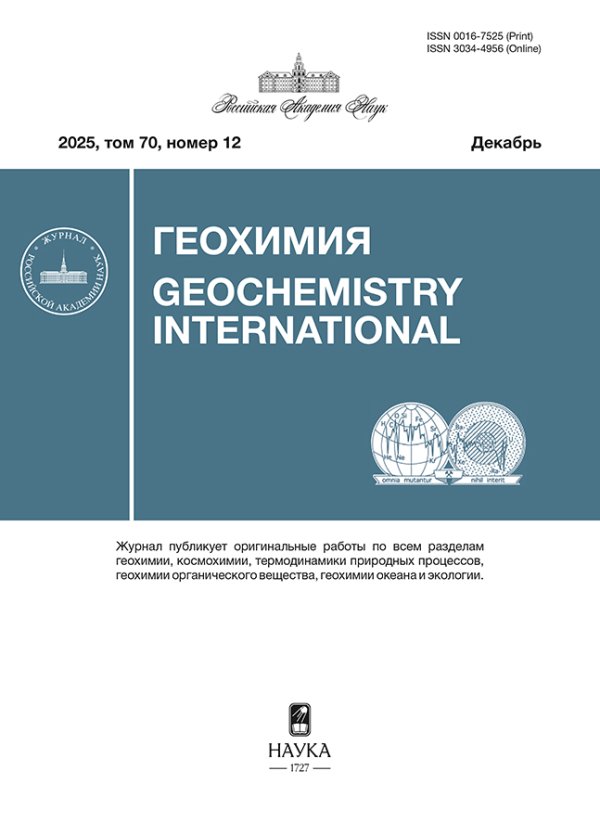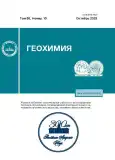Development Vernadsky’ works on natural waters: biosphere processes and water quality
- Authors: Moiseenko T.I.1
-
Affiliations:
- Vernadsky Institute of Geochemistry and Analytical Chemistry RAN
- Issue: Vol 68, No 10 (2023)
- Pages: 1009-1020
- Section: Articles
- URL: https://journals.rcsi.science/0016-7525/article/view/140397
- DOI: https://doi.org/10.31857/S0016752523100084
- EDN: https://elibrary.ru/VUZPIJ
- ID: 140397
Cite item
Full Text
Abstract
The article considers the increasing of anthropogenic loads on surface waters. An analysis of the works of V.I. Vernadsky about natural waters and their importance in assessing modern biogeochemical processes. The scales of the input of elements and substances into the modern biosphere, such as the emission of greenhouse gases, the dispersion of nitrogen and phosphorus, acid-forming gases, as well as metals, are shown. Key changes covering regions and the biosphere as a whole are noted. Examples of the consequences of the development of anthropogenically induced processes in surface waters are given on the example of Arctic remote regions - the Kola North of Russia: the impact of climate warming, acidification, eutrophication and enrichment of waters with metals. Within the concept of V.I. Vernadsky about the role of natural waters in the life support of Planet population, approaches to assessing the quality of waters from the standpoint of the ecological paradigm are given.
About the authors
T. I. Moiseenko
Vernadsky Institute of Geochemistry and Analytical Chemistry RAN
Author for correspondence.
Email: moiseenko.ti@gmail.com
Kosygin st., 19, Moscow 119991, Russia
References
- Абакумов В.А., Тальских В.Н., Попченко В.И., Булгаков Г.П., Свирская Н.Л., Кринева С.В., Попченко И.И., Семин В.А., Хромов В.М., Распопов И.М., Марголина Г.Л., Воронова Л.Д., Пушкарь И.Н. (1992) Руководство по гидробиологическому мониторингу пресноводных экосистем. Гидрометеоиздат, Санкт-Петербург, 320 с.
- Алекин, О.А. (1970) Основы гидрохимии, 2-е издание. Гидрометеорологическое издательство, 444с.
- Вернадский В.И. (1991) Научная мысль как планетное явление. М.: Наука, 270 с.
- Вернадский В.И. (2003) История природных вод. В.И. Вернадский; отв. ред. С.Л. Шварцев, Ф.Т. Яншина. М.: Наука, 750 с.
- Георгиади А.Г., Коронкевич Н.И., Барабанова Е.А., Кашутина Е.А., Милюкова И.П. (2019) О вкладе климатических и антропогенных факторов в изменения стока крупных рек русской равнины и Сибири. ДАН. 488(5), 539-544.
- Данилов-Данильян В.И., Рейф И.Е. (2016) Биосфера и цивилизация. М.: Энциклопедия, 432 с.
- Ермаков В.В (2017) Концепция биогеохимических провинций А.П. Виноградова и ее развитие. Геохимия. (10), 875-890.
- Ermakov V.V. (2017) A.P. Vinogradov’s concept of biogeochemical provinces and its development. Geochem. Int. 55(10), 872-886.
- Ермаков В.В., Ковальский Ю.В. (2018) Живое вещество биосферы: масса и химический элементный состав. Геохимия. (10), 931-944.
- Ermakov V.V., Kovalsky Y.V. (2018) Living matter of the biosphere: mass and chemical elemental composition. Geochem. Int. 56(10), 969-981.
- Минеральные ресурсы мира. (2002) Статистический справочник (издание официальное) МПР РФ ФГУНПП “Аэрогеология”. Информационно-аналитический центр “Минерал”, Москва
- Моисеенко Т.И. (2017) Эволюция биогеохимических циклов в современных условиях антропогенных нагрузок: пределы воздействий. Геохимия. (10), 841-862.
- Moiseenko T.I. (2017) Evolution of biogeochemical cycles under anthropogenic loads: limits impacts. Geochem. Int. 55(10), 841-860.
- Моисеенко Т.И. (2019) Биодоступность и экотоксичность металлов в водных системах: критические уровни загрязнения. Геохимия. 64(7), 675-688.
- Moiseenko T.I. (2019) Bioavailability and Ecotoxicity of Metals in Aquatic Systems: Critical Contamination Levels. Geochem. Int. 57(7), 737-750.
- Моисеенко Т.И. (2008) Концепция “здоровья” экосистемы в оценке качества вод. Экология. 6, 411-419.
- Никаноров A.M. (2015) Фундаментальные и прикладные проблемы гидрохимии и гидроэкологии. Ростов-на-Дону: Южный федеральный университет, 572 с.
- Перечень рыбохозяйственных нормативов предельно допустимых концентраций (ПДК) и ориентировочно безопасных уровней воздействия (ОБУВ) вредных веществ для воды водных объектов, имеющих рыбохозяйственное значение (1999) М.: Изд-во ВНИРО, 304 с.
- Руднева И.И., Залевская И.Н., Шайда В.Г., Меметлаева Г.Н., Щерба А.В. (2020) Биогенная миграция азота и фосфора в соленых озерах Крыма: сезонные аспекты. Геохимия. 65(10), 984-997.
- Rudneva I.I., Zalevskaya I.N., Shaida V.G., Memetlaeva G.N., Scherba A.V. (2020) Biogenic Migration of Nitrogen and Phosphorus in Crimean Hypersaline Lakes: A Seasonal Aspect Geochem. Int. 58(10), 1123-1134.
- Ферсман А.П. (1934) Геохимия. Т. 2. Ленинград: О-НТИ-ХИМТЕОРЕТ, 354 с.
- Эдельштейн К.К. (2023) Гидрология материков. M.: Юрайт, 297 с.
- Abid A.A., Gill S.S. (2014) Eutrophication: Causes, Consequences and Control Volume 2. Springer Dordrecht Heidelberg London New York, 262 pp.
- AMAP. IASC (2016) Arctic Freshwater System in a Changing Climate, WCRP CliC Project. CliC/AMAP/IASC. http://www.amap.no/documents/doc/The-Arctic-Freshwater-System-in-a-Changing-Climate/1375.
- AR5 Synthesis Report: Climate Change, 2014. https://www.ipcc.ch/report/ar5/syr/Ar5/ar5.html
- AR6 Climate Change 2022: Mitigation of Climate Change – IPCC. Sixth Assessment Report, 2022. https://www.ipcc. ch/report/sixth-assessment-report.
- Bjerregaard P., Andersen O. (2014) Ecotoxicology of Metals – Sources, Transport, and Effects in the Ecosystem; In Handbook on the Toxicology of Metals (Eds. Nordberg G.F., Fowler B.A., Nordberg M.), Amsterdam: Elsevier.
- Bouwman A.F., Beusen A.H.W., Lassaletta L., van Apeldoorn D.F., van Grinsven H.J.M., Zhang J., van Ittersum M.K. (2017) Lessons from temporal and spatial patterns in global use of N and P fertilizer on cropland. Scientific Reports. 7(1), 40366. https://doi.org/10.1038/srep40366
- Bryan G.W. (1976) Heavy metal contamination in the sea. Marine Pollution (R. Johnston, ed.), p. 185-302.
- Clair T.A., Dennis I.F., Vet R. (2011) Water chemistry and dissolved organic carbon trends in lakes from Canada’s Atlantic Provinces: no recovery from acidification measured after 25 years of lake monitoring. J. Fish. Aquat. Sci. 68, 663-674.
- Clark J.M., Bottrell S.H., Evans C.D., Monteith D.T., Bartlett R., Rose R., Newton R.J., Chapman P.J. (2010) The importance of the relationship between scale and process in understanding long-term DOC dynamics. Sci. Total Environ. 408, 2768.
- Corman J.R., Bertolet B.L., Casson N.J., Sebestyen S.D., Kolka R.K., Stanley E.H. (2018) Nitrogen and phosphorus loads to temperate seepage lakes associated with allochthonous dissolved organic carbon loads. Geophysical Research Letters. 45, 5481-5490.
- De Wit H.A., Stoddard J.L., Monteith D.T., Sample J.E., Austnes K., Couture S., Fölster J., Higgins S.N., Houle D., Hruška J., Krám P., Koṕacek J., Paterson A.M., Valinia S., Van Dam H., Vuorenmaa J., Evans C.D. (2021) Cleaner air reveals growing influence of climate on dissolved organic carbon trends in northern headwaters. Environ. Res. Lett. 16, 104 009.
- European Commission. Directive 2013/39/EC Amending Directives 2000/60/EC and 2008/105/EC as Regards Priority Substances in the Field of Water Policy. 2013/39/EC; 2013.
- Gashkina N.A., Moiseenko T.I., Shuman L.A., Koroleva I.M. (2022) Biological responses of whitefish (Coregonus lavaretus L.) to reduced toxic impact: Metal accumulation, haematological, immunological, and histopathological alterations. Ecotoxicology and Environmental Safety. 239, 113 659. https://doi.org/10.1016/j.ecoenv.2022.113659
- Graedel T.E., Benkovitz C.M., Keene W.C., Lee D.S., Marland G. (1995) Global emission inventories of acid-related compounds. Water, Air and Soil Pollut. 85, 25-36.
- Grosse G., Goetz S., McGuire A.D., Romanovsky V.E., Schuur E.A. (2016) Changing permafrost in a warming world and feedbacks to the Earth system. Environ Res Lett. 11, 040 201.
- Gruber N., Galloway J.N. (2008) An Earth-system perspective of the global nitrogen cycle. Nature. 451, 293-296.
- Kvaeven B., Ulstein M.J., Skjelkvåle B.L. (2001) ICP Waters – An international program for surface water monitoring. Water Air Soil Pollut. 130, 775-780.
- Malkova G., Drozdov D., Vasiliev A., Gravis A., Kraev G., Korostelev Y., Nikitin K., Orekhov P., Ponomareva O., Romanovsky V. et al. (2022) Spatial and Temporal Variability of Permafrost in the Western Part of the Russian Arctic. Energies. 15, 2311. https://doi.org/10.3390/en15072311
- Meingast K.M., Kane E., Coble A.A., Marcarelli A.M., Toczydlowski D. (2020) Climate, snowmelt dynamics and atmospheric deposition interact to control dissolved organic carbon export from a northern forest stream over 26 years. Environ Res Lett. 15, 104034.
- Moiseenko T.I., Dinu M.I., Gashkina N.A., Kremleva T.A. (2019) Aquatic environment and anthropogenic factor effects on distribution of trace elements in surface waters of European Russia and Western Siberia. Environ Res Lett. 14, 065010. https://doi.org/10.1088/1748-9326/ab17ea
- Moiseenko T., Sharov A. (2019) Large Russian lakes Ladoga, Onega, and Imandra under strong pollution and in the period of revitalization: a review. Geosciences. 9(12), 492. https://doi.org/10.3390/geosciences9120492
- Moiseenko T.I., Gashkina N.A., Dinu M.I. (2020) Metal bioavailability in northern low-salinity water: Case study of lakes in the Kola region, Russia. Case study of lakes in the Kola region. Environ Res Lett. 15, 095005. https://doi.org/10.1088/1748-9326/ab9b40
- Moiseenko T.I., Bazova M.M., Gashkina N.A. (2022) Development of Lake from Acidification to Eutrophication in the Arctic Region under Reduced Acid Deposition and Climate Warming. Water. 14, 3467. https://doi.org/10.3390/w14213467
- Moiseenko T.I., Dinu M.I., Bazova M.M., Heleen A. de Wit. (2015) Long-term changes in the water chemistry of subarctic lakes as a response to reduction of air pollution: case study in the Kola North, Russia. Water, Air, & Soil Pollution. 226(98), 1-12.
- Moiseenko T.I., Skjelkvåle B.L., Gashkina N.A., Shalabodov A.D., Khoroshavin V.Yu. (2013) Water chemistry in small lakes along a transect from boreal to arid ecoregions in European Russia: Effects of air pollution and climate change. Applied Geochemistry. 28, 69-79.
- Moiseenko T.I., Dinu M.I., Gashkina N.A., Jones V., Khoroshavin V.Y., Kremleva T.A. (2018) Present status of water chemistry and acidification under nonpoint sources of pollution across European Russia and West Siberia. Environ Res Lett. 13, 105007.
- Monteith D.T., Stoddard J.L., Evans C.D., de Wit H.A., Forsius M., Hogasen T., Wilander A., Skjelkvale B.L., Jeffries D.S., Vuorenmaa J., Keller B., Kopacek J. and Vesely J. (2007) Dissolved organic carbon trends resulting from changes in atmospheric deposition chemistry. Nature. 450, 537-539.
- Moore J.W., Ramamurthy S. (1984) Heavy metals in natural waters. Monitoring and impact assessment. Springer, 288 p.
- Newman M.C., Clements W.H. (2009) Aquatic Toxicology: Concepts, Practice, New Directions. In book: General, Applied and Systems Toxicology. https://doi.org/10.1002/9780470744307.gat092
- Rockström W., Noone S.K., Persson Å., Chapin III F.S., Lambin E.F., Lenton T.M., Scheffer M. (2009) A safe operating space for humanity. Nature. 461, 472-475.
- Rudneva I.I., Gaisky P.V., Shaida V.G., Shaida O.V. (2023) Assessing Climate and Human Activity Effects on Hypersaline Lake Ecosystem: Case Study of Saki Lake, Crimea. Water. 15, 456. https://doi.org/10.3390/w15030456
- Stoddard J.L., Van Sickle J., Herlihy A.T., Brahney J., Paulsen S., Peck D.V. et al. (2016) Continental-scale increase in lake and stream phosphorus: Are oligotrophic systems disappearing in the United States? Environ Sci Technol. 50, 3409-3415.
- Strock K.E., Theodore N., Gawley W.G., Ellsworth A.C., Saros J.E. (2017) Increasing dissolved organic carbon concentrations in northern boreal lakes: implications for lake water transparency and thermal structure. J. Geophys Res Biogeosci. 122, 1022-35.
- Tussupova K., Hjorth A.P., Morave M. (2020) Drying lakes: A review on the applied restoration strategies and health conditions in contiguous areas. Water. 12, 749.
- U.S. EPA. National Recommended Water Quality Criteria. Report 4304T. Office of Water, Office of Science and Technology. (EPA/600/4-91/002) Springfield, Virginia, 2007
- UN World Water Development Report: Valuing Water, 2021. https://www.unwater.org/publications/un-world-water-development-report-2021
- Väänänena K., Leppänen M.T., Chen X., Akkanenaa J. (2018) Metal bioavailability in ecological risk assessment of freshwater ecosystems: from science to environmental management. Ecotoxicol Environ Saf. 147, 430-446.
- Vasseur P., Masfaraud J.-F., Blaise C. (2021) Ecotoxicology, revisiting its pioneers. Environ Sci. Pollut Res Int. 28(4), 3852-3857. https://doi.org/10.1007/s11356-020-11236-7
- Water Security Under Climate Change Editors: Asit K. BiswasCecilia Tortajada Copyright: 2022 Published: 29 September 2021. Springer Nature Singapore Pte Ltd, 2022, 830 p. https://doi.org/10.1007/978-981-16-5493-0
- Xiang G. (2013) Permafrost degradation and methane: low risk of biogeochemical climate-warming feedback. Environ Res Lett. 8, 035014.
- Zhang X., Davidson E.A., Zou T., Lassaletta L., Quan Z., Li T., Zhang W. (2020) Quantifying nutrient budgets for sustainable nutrient management. Global Biogeochemical Cycles. 34, e2018GB006060. https://doi.org/10.1029/2018GB006060












